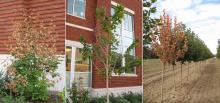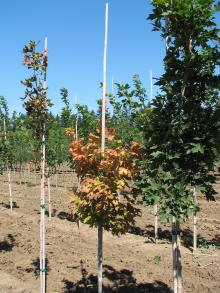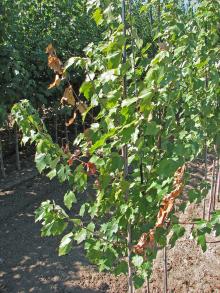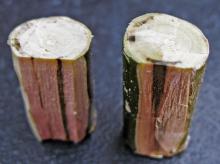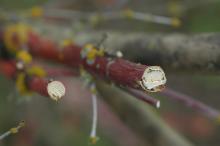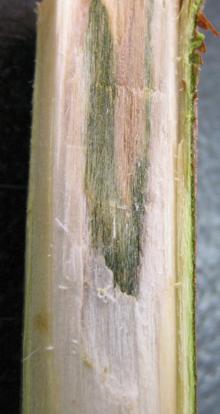See:
Verticillium Wilt in the Pacific Northwest
Cause Samples with Verticillium wilt have dominated the maple problem diagnoses sent to the Oregon State University Plant Clinic. Verticillium dahliae, a soilborne fungus that is almost impossible to eradicate once established in the soil. There are over 300 plant species susceptible to this fungus. It forms microsclerotia that germinate in response to exudates from roots that are growing nearby. Mycelia from the microsclerotia infect the roots. The fungus grows into the xylem where it colonizes the plant through mycelial growth and conidial production. Fluid movement in the xylem passively transports the conidia. Once in the xylem, this fungus partially blocks water movement and produces toxins that result in wilt symptoms. The cambium may die, resulting in an elongate canker, which can be colonized by other pathogens such as Nectria sp. and Cytospora sp. Current-season sapwood may not be infected, and symptoms may not reappear; or infection may occur without foliar symptoms. This may result in branch dieback or bud failure in spring.
After diseased plant parts die, microsclerotia form inside the tissue. Once the infected tissue decays, microsclerotia are released and can survive several years in soil. Many weeds are susceptible and can help the fungus survive and disperse. Plant-parasitic nematodes also can increase Verticillium wilt incidence and severity. Other diseases, such as bacterial dieback, can also increase in incidence and severity on trees with Verticillium wilt. The Norway maple cultivars Jade Glen and Parkway are tolerant and have few symptoms.
Symptoms Leaves on one side of the tree or on just an individual branch suddenly wilt and die. Leaves are yellowish and smaller than normal. Leaf scorch can also occur at leaf margins. Leaves die and fall or hang on dead branches. Later, other limbs wilt and die. Greenish streaks or bands that follow the grain can be found in sapwood but perhaps not in the earliest stages of infection. In cross sections of the stem, vascular discoloration will appear in rings or arcs. Vascular discoloration is more likely to be found in larger branches and trunks. Infected trees may die within a few weeks or live for years.
Note: Very similar symptoms occur with a newly described disease called vascular streak dieback disease caused by Ceratobasidum theobromae (formerly Rhizoctonia sp.).
Sampling Send soil samples to any of various private and public laboratories to assay for Verticillium propagules. Nurseries may wish to test individual core samples to determine the distribution in a particular field. The presence of any microsclerotia in the soil should be interpreted as a potential disease risk.
Cultural control
- Prune off and burn affected limbs preferably before leaves fall and thus before new inoculum is incorporated into the ground.
- Clean pruning equipment after use.
- Do not track soil from infested areas into clean areas. Clean boots, equipment, and tools before leaving an infested area.
- Keep nitrogenous fertilizers to a minimum-enough only to produce normal, not succulent, growth.
- If the tree dies and/or is removed, replace it with a nonsusceptible host such as any conifer, birch, dogwood, or sycamore.
- Avoid planting maple in fields with a history of Verticillium wilt. Avoid fields previously planted to potato or tomato; however, former peppermint fields may be lower risk.
- A preplant soil test for Verticillium propagules will help determine a planting site.
- Incorporating freshly mown Italian ryegrass followed by covering the soil with plastic for 3 months in the late summer was effective in the Netherlands at reducing disease incidence in a nursery crop of Norway maple planted 6 months later. Effect was observed up to 4 years after planting.
Chemical control Research in California and Florida has not identified any nonfumigant chemicals or microbial based products that provide consistently effective control of Verticillium wilt of strawberry (the same disease of maple).
- Preplant fumigation has been effective for short-term crops such as annuals or perennials grown for a season or two but not for long term perennials grown for multiple years in the same locations.
- Vapam HL at 37.5 to 75 gal/A. Immediately roll the soil and follow up with tarps or a light watering. May use through an irrigation system. 5-day reentry. Restricted-use pesticide.
- A few chemicals are registered for tree injection as a preventative treatment. Do not inject trees less than 2 inches in diameter or that are suffering from various stresses.
- Fungisol for spring application only. Washington and Idaho only.
Note Although Phyton 27 is registered as a spray it is not recommended based on a single trial where it was ineffective when used before or after infection.
References Goud, J.C., Termorshuizen, A.J., Blok, W.J. and van Bruggen, H.C. 2004. Long-term effect of biological soil disinfestation on Verticillium wilt. Plant Disease 88:688-694.
Pscheidt, J.W., and J.P. Bassinette. 2009. Evaluation of Phyton-27 for control of Verticillium wilt on Japanese Maple, 2006-2008. PDMR 3:OT024.
Townsend, A.M., Schreiber, L.R., Hall, T.J., and Bentz, S.E. 1990. Variation in response of Norway maple cultivars to Verticillium dahliae. Plant Disease 74:44-46.

